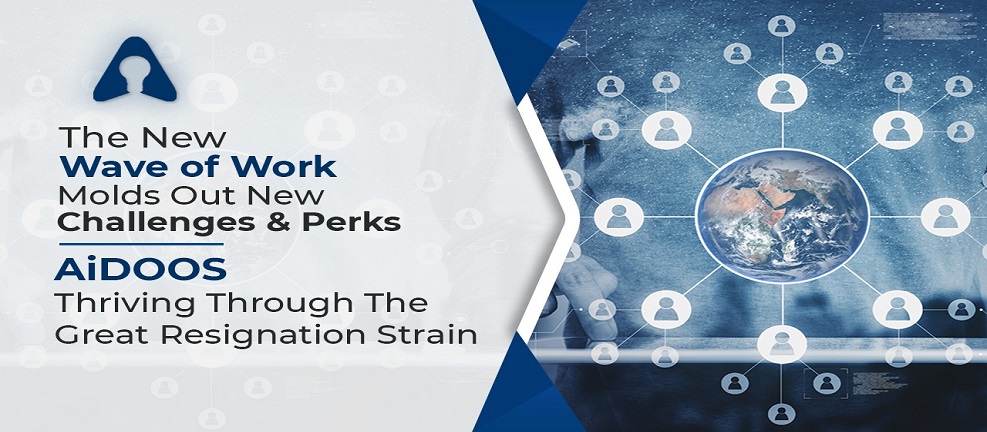Building a Safety Net for CIOs Amidst the Great Resignation

As per the report of US Bureau of Labor Statistics, 4.5 million Americans quit their jobs in the month of November 2021. Resignations have remained abnormally high for the last several months. Furthermore, according to LinkedIn’s job-seekers research, 82 percent of the Indian workforce expressed an interest in switching jobs in 2022.
Managers are now navigating the ripple effects of the pandemic, as employees re-evaluate their careers and leave their jobs in record numbers. Companies are keen to explore the reason that drives this recent shift. The highest resignation rates are among mid-career employees and the worst hits are technology and healthcare industries.
ILO Monitor stated that around 114 million people lost their jobs over 2020, while the United Nations recorded the Covid jobs crisis 'most severe' since the 1930s. The pandemic caused an "unprecedented" hit to the global economy in 2020, destroying the equivalent of 225 million full-time jobs, as per the UN. According to this data, at the onset of the pandemic, the job market was struggling with uncertainty and mass layoffs. The number of people who lost their jobs went in millions, and those lucky enough to remain employed remained put in their roles for survival.
However, now as the world turns towards recovery, workers in privileged positions who don’t primarily depend on paycheck to paycheck are finally moving on. It is noticed that non-developed nations with the absence of social security and unemployment benefits cannot afford this luxury. But they still undergo duress and pent-up frustration from the disruption caused by the pandemic.
According to a survey by Quess in 2021, the 'Great Resignation' is an unending talent surge that has broken the demand-supply equilibrium, compelling organizations to focus on both talent acquisition and retention at the same time.
A shift to work-from-home culture, desire to move into a more suitable profession and long-term goals fueled this whole new trend. Remote working has made it possible for corporates and employees to have flexible work models. Hence, many employers started offering better benefits and higher salaries to employees, leading employees to re-evaluate their options.
Here’s where the fuel for startup platforms like AiDOOS comes from. AiDOOS is an online platform that bridges the gap between the IT needs of organizations and talents seeking work opportunities. As one of the worst-hit industries due to the Great Resignation is technology, the platform can be a great choice for both employers and IT experts.
AiDOOS’s vision aligns with the future of the work model and utilizes Web 3.0 as well as curator economy. Now, as people prefer to work remotely, they can move to AiDOOS which offers them a continuous flow of work and the benefit of making a team of their own with like-minded people. The platform survives the Great Resignation trend and in fact is a boon to employers as well because now, they can push their IT requirements to the platform, so an IT professional adept in the field can perform and deliver the task. What’s more intriguing about AiDOOS is it gives the power to choose tasks to the IT experts and there is no bidding time for them to sit idle, waiting for the opportunity to arrive.
Great minds from across the globe come together, form teams, and serve enterprises in a simple, secure, and reliable manner. Enterprises can now depend on AiDOOS for getting global talents and stop their hustle of hiring an IT team or different freelancers. Their safety net when it comes to IT is AiDOOS amidst the Great Resignation Wave.
Working with the future of work model, the platform is already ahead of any competitor and is one-of-a-kind when it comes to targeting the most important niche. It is certain that several startups will see the sun, but AiDOOS has the advantage of making the first move. It is yet to be seen if the platform extends to new industries and becomes an umbrella, or continues to flourish and take advantage of advancements and existing and new needs in the IT sector.
In the era of the Great Resignation, Virtual Delivery Centers (VDCs) provide a robust solution for CIOs grappling with talent shortages and workforce transformation. Here's how VDCs serve as the ultimate safety net:
Access to a Global Talent Pool: VDCs eliminate geographical boundaries, enabling CIOs to tap into a global pool of subject matter experts, ensuring that the right skills are always available for critical projects.
Scalable Workforce: The flexibility of VDCs allows organizations to scale their teams up or down based on project demands, ensuring optimal resource utilization without the need for permanent hires.
Retention of Expertise: By focusing on task-based delivery rather than traditional employment, VDCs ensure that businesses have continuous access to expertise without the risks of turnover.
Reduced Onboarding Time: VDCs streamline the onboarding process by leveraging pre-vetted professionals ready to deliver, reducing downtime and enabling faster project kick-offs.
Enhanced Employee Satisfaction: VDCs provide a modern work model that aligns with the priorities of today’s workforce, such as remote work flexibility, autonomy, and engaging projects, helping retain top talent.
Minimized Disruption: As employees leave or shift roles, VDCs fill gaps seamlessly, ensuring that CIOs can maintain business continuity and meet organizational goals.
Cost-Effective Talent Management: VDCs reduce overhead costs by removing the need for traditional hiring cycles, training programs, and infrastructure, while maintaining high-quality output.
By adopting the VDC model, CIOs can safeguard their organizations against the challenges of the Great Resignation, creating a resilient and adaptable workforce that thrives in today’s dynamic business environment.

For modern telecom enterprises, delivering exceptional QoS is no longer optional—it’s a brand differentiator and a strategic lever for growth. Static provisioning models won’t cut it in a world of hyper-dynamic data usage.